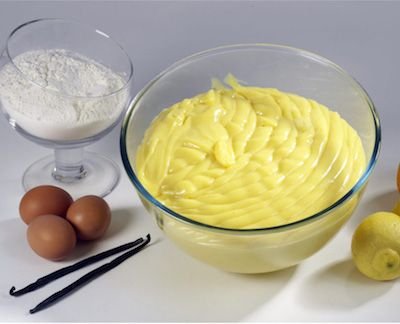
Custard cream is a basic ingredient in many cakes and pastries. Altought the preparation may sound simple, some details need extreme care for an optimal result!
La crema pasticciera è un ingrediente di base per torte e pasticcini. Anche se la preparazione può sembrare semplice, bisogna fare estrema attenzione ai dettagli per un ottimo risultato!

INGREDIENTI:
- Tuorli 100 g
- Vaniglia 1 baccello
- Zucchero granulato 100 g
- Scorza di limone ⅓
- Amido di riso (o di mais) 25 g
- Latte intero 250 g
PRODURRÀ ≅ 400 g di crema
METODO DI COTTURA:
BAGNO-MARIA
Usare questo metodo per una cottura delicata della crema.
Sospendi una pentola in un'altra con il fondo solo a contatto dell'acqua bollente.CUCINA A INDUZIONE
Semplicemente usa una pentola invece del bagno-maria.
PREPARAZIONE:
Riporre una ciotola di vetro nel freezer per poterla usare più tardi.
Riporre il latte intero in una piccola pentola e portare a ebollizione.
Durante il riscaldamento grattugiare ⅓ della pelle di un limone (solo la buccia, non il bianco sotto pelle).
Riporre la bacca di vaniglia nel latte.
In una ciotola di vetro mescolare a secco lo zucchero e l'amido, quindi aggiungere i tuorli.
Versare una piccola quantità del latte bollente nella ciotola di vetro con i tuorli mescolando velocemente evitando grumi.
Versare nuovamente il latte rimanente in due volte nei tuorli mescolando velocemente evitando grumi.
Trasferire il composto nel bagno-maria riscaldando fino a 92°C mescolando velocemente. (controllare la temperatura con un termometro). Se invece si usa la cucina a induzione riusare la stessa pentola dove si è bollito il latte.
Raggiunta la temperatura desiderata trasferire subito il composto nella ciotola di vetro precedentemente raffreddata nel freezer sempre mescolando velocemente raffreddando il composto fino a 40°C.
Spolverare leggermente la superficie della crema con lo zucchero granulato per evitare la formazione della "pelle", raschiare i bordi della ciotola e riporre in frigo a riposare a 4°C.

INGREDIENTS:
- Egg Yoke 100 g
- Vanilla 1 pod
- Sugar granulated 100 g
- Lemon peel ⅓
- Rice starch (or corn starch) 25 g
- Milk whole 250 g
WILL MAKE ≅ 400 g of cream
COOKING METHOD:
BAIN-MARIE
Use this method for a gentle cooking of the cream.
Suspend a pot into another pot with the bottom touching the boiling water only.INDUCTION COOKER
Just use a normal pot instead of the bain-marie method.
PREPARATION:
Place a glass bowl in the freezer to be used later on.
Place the whole milk in a small pot and bring to boiling.
While heating up grate ⅓ of a lemon peel (just the coloured layer, don’t grate the white layer).
Place the vanilla pod internal in the milk.
In a glass bowl dry mix the sugar with the starch then add the egg yokes.
Pour a small quantity of the boiled milk in the glass bowl with the yokes while mixing very fast making a uniform blend.
Pour again the remaining milk in two times into the yokes while mixing very fast making a uniform blend.
Transfer the compound in the bain-marie heating up to 92°C while mixing very fast. (temperature can be checked with a thermometer). If using the induction cooker method instead reuse again the same pot where the milk was boiling.
When reached the desired temperature immediately transfer the compound to the chilled glass bowl previously placed in the freezer, while keeping mixing very fast cooling down the compound to 40°C.
Sprinkle some granulated sugar on the surface of the cream to avoid the formation of a top “skin” layer, clean the bowl wall and place the bowl in the fridge at 4°C to rest.
NOTE:
The ideal cooking temperature of the yoke depends of the quantity of yoke itself. The egg yoke commence coagulate at 52°C and complete at 67°C then it degenerate. For this recipe and this quantity of yoke the ideal temperature will be 92°C but must be reached rapidly and then need to be cool down very fast at a temperature lower than the point of cooking (52°C) ideally 40°C in order to obtain a lucid compound without lumps. If the temperature is bring down at 10°C we’ll also get pasteurisation.
NOTA:
La temperatura di cottura ideale dei tuorli dipende dalla quantità deli stessi. I tuorli iniziano a coagulare a 52°C e completano a 67°C, poi degenereranno. Per questa ricetta e questa quantità di tuorli la temperatura ideale sarà di 92°C ma deve essere raggiunta rapidamente e successivamente raffreddata velocemente a una temperatura inferiore di quella di cottura (52°C) idealmente 40°C in modo da ottenere un composto lucido e non grumoso. Se la temperatura viene portata al di sotto dei 10°C otterremo anche la pastorizzazione.
Buonissima! Io uso la farina al posto del amido di mais 😊
credo che non ci siano problemi...personalmente non cambio il mio winning team quando è consolidato!! :))
E fai bene 😊
Oh mamma bona!
This post has been ranked within the top 50 most undervalued posts in the first half of Sep 13. We estimate that this post is undervalued by $25.61 as compared to a scenario in which every voter had an equal say.
See the full rankings and details in The Daily Tribune: Sep 13 - Part I. You can also read about some of our methodology, data analysis and technical details in our initial post.
If you are the author and would prefer not to receive these comments, simply reply "Stop" to this comment.
STOP
Only the post author has the authority to stop these comments on their posts. However, your preference has been noted and we will refrain from posting these comments on your posts.